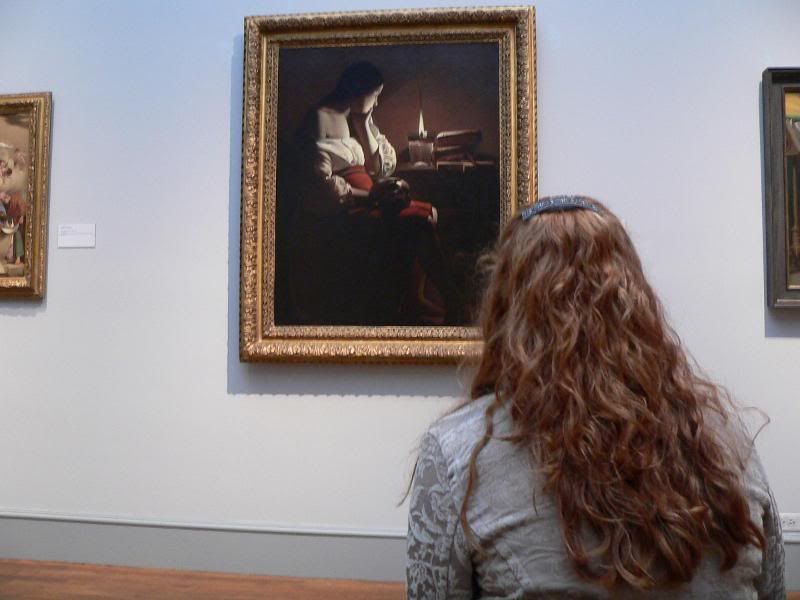- Early Medieval Art: Carolingian, Ottonian, Romanesque - John Beckwith
Wednesday, August 30, 2006
Early Medieval Art
Posted by Heather at 11:39 PMTuesday, August 29, 2006
April Blood
Posted by Heather at 1:17 AM- April Blood: Florence and the Plot Against the Medici - Lauro Martines
I really liked this book. Sometimes the organization of the chapters seemed a little awkward, but I understood why they were set up that way so I got over it. The information in the text more than maked up for that. This is probably the most thourough explaination of the Pazzi Conspiracy I've read to date. Martines goes into the political background that led to the events, the different stages of the planning, the histories of the conspirators, their confessions, punishments, and of course a detailed explaination of how the assassination of Giuliano and the attempt on Lorenzo changed the course of Florentine history.
At the end, Martines tries to summorize the overall effects and the future of Florence. The information was helpful, but you could tell that the author was trying to conclude the book toward the end of chapter 13 and through all of chapter 14. I started thinking he was rushing to finally be done with the book, but again, the information more than made up for that. Also, the book does not idealize Lorenzo de' Medici, which is rare. Martines presents the positives and the negatives. It took some getting use to after The Agony and the Ecstasy depicts him as the type of father figure you'd love to have.
Friday, August 25, 2006
Question?
Posted by Heather at 12:39 AMI've kind of made it a tradition to re-read The Agony and the Ecstasy at least every other year. Do you think I should keep this up? I know that I could be learning more from another book on Michelangelo, but am I actually wasting time by re-reading? Or am I just solidifying my knowledge in a memoriable, historical-fiction way?
Tuesday, August 22, 2006
The Name of the Rose
Posted by Heather at 3:46 PM- The Name of the Rose - Umberto Eco
I really liked this book. I thought that the story was interesting, but more importantly I loved the historical quality of it. Umberto Eco did a lot of research before writing the book and he goes to great lengths to establish the aura of the era. He sticks you in the middle of of a monastary in the middle ages, and he does so rather accurately. While some people may not enjoy the random tangent into ancient texts and medicinal herbs I was delighted by the fact that the author did not stray away from these additions. Most authors assume they are writing for the masses, and that the typical person would get lost, while Umberto Eco includes it because it is true to the era. He takes a leap of faith and hopes that his reader will be intelligent enough to understand it, rather than neglect the additions at the expense of the setting. The book is rampant with symbolism and quotes on knowledge, faith, the ancients, monastic life, inquisitors, etc. I don't think that this book is for everyone, but I enjoyed it.
Friday, August 18, 2006
Mesopotamia
Posted by Heather at 12:02 PM- Mesopotamia: The Invention of the City - Gwendolyn Leick
Leick's book is meant for someone who at least has a background knowledge of Mesopotamia and the battles between the Assyrians and Babylonians. Also, I suggest the reader stop between chapters to reflect on that particular city, or else keep a reading log of some sort so as not to mix up the cities. Overall I enjoyed the book, but I wish Leick would have included more photographs and that some would be in color. It's difficult to grasp the beauty of the Ishtar Gate in black and white. Also, it would have been nice to have seen the entire Ishtar Gate rather than just the dragonish creature since she spends so much time talking about it being shipped to Germany and its reconstruction.
Tuesday, August 08, 2006
Girl in Hyacinth Blue
Posted by Heather at 1:09 AM- Girl in Hyacinth Blue - Susan Vreeland
Monday, August 07, 2006
A Confederacy of Dunces
Posted by Heather at 12:46 AM- A Confederacy of Dunces - John Kennedy Toole
Honestly, the best way to describe it is for me to quote a review from the Chicago Sun-Times on the back of the book. Henry Kisor wrote, "A Confederacy of Dunces is an American comic masterpiece. John Kennedy Toole's hero is one Ignatius J. Reilly, 'huge, obese, fractious, fastidious, a latter-day Gargantua, a Don Quixote of the French Quarter. His story burst with wholly original characters, a denizen of New Orleans' lower depths, incredibly true-to life dialogue, and the zaniest series of high and low comic adventures.'"
I found myself wondering how it was all going to come together in the end, but he managed to tie the characters together in a series of odd events. I think it's safe to assume that you'll never read a book quite like this one.
Wednesday, August 02, 2006
Reading Lolita
Posted by Heather at 11:42 AM- Reading Lolita in Tehran: A Memoir in Books - Azar Nafisi




